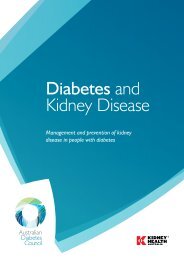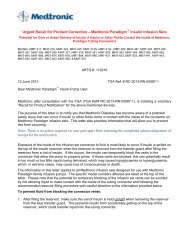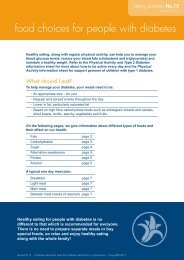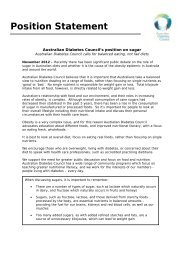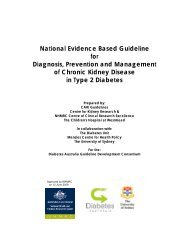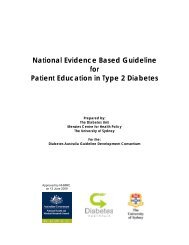O MeA e tAtAU OnA e IlOA - Australian Diabetes Council
O MeA e tAtAU OnA e IlOA - Australian Diabetes Council
O MeA e tAtAU OnA e IlOA - Australian Diabetes Council
You also want an ePaper? Increase the reach of your titles
YUMPU automatically turns print PDFs into web optimized ePapers that Google loves.
Chronic complications - continued<br />
other important nutrients to your heart. Blood vessels to your heart can become partially or<br />
totally blocked by fatty deposits. Chest pain (angina) or a heart attack occurs when the blood<br />
flow supplying oxygen to your heart is reduced or cut off.<br />
Over time, coronary artery disease can weaken the heart muscle and lead to heart failure<br />
preventing the heart from pumping blood properly to the rest of the body. This can also lead<br />
to abnormal beating rhythms of the heart.<br />
A stroke occurs when blood supply to part of your brain is interrupted and brain tissue is<br />
damaged. The most common cause is a blocked blood vessel. Stroke can cause physical<br />
problems such as paralysis, problems with thinking or speaking, and emotional problems.<br />
Peripheral artery disease occurs when blood vessels in your legs are narrowed or blocked<br />
by fatty deposits causing reduced blood flow to your legs and feet.<br />
Many people with diabetes and peripheral artery disease do not have any symptoms.<br />
Other people may have the following symptoms:<br />
• leg pain, particularly when walking or exercising, which disappears after a few minutes of rest<br />
• numbness, tingling, or coldness in the lower legs or feet<br />
• sores or infections on feet or legs that heal slowly.<br />
Certain exercises, such as walking, can be used both to treat peripheral arterial disease and<br />
to prevent it. Medications may help relieve symptoms. In advanced cases treatment may<br />
involve surgical procedures.<br />
You can lower your risk of blood vessel damage by keeping your blood glucose, blood<br />
pressure and cholesterol in the recommended range with healthy eating, physical activity,<br />
and medication. Quitting smoking is essential to lower your risk.<br />
<strong>Diabetes</strong> and infection:<br />
High blood glucose levels can lower your resistance to infection and can slow the healing<br />
process.<br />
Oral health problems and diabetes<br />
When diabetes is not controlled properly, high glucose levels in saliva may increase the<br />
amount of bacteria in the mouth and may also cause dryness of the mouth. Blood glucose<br />
(sugar) levels that stay high for long periods of time reduces the body’s resistance to<br />
infection, and the gums are likely to be affected.<br />
Periodontal diseases are infections of the gums and bones that hold your teeth in place. Even<br />
if you wear dentures, you should see your dentist at least once a year.<br />
Signs and symptoms of oral health problems include:<br />
• Gums that are red and swollen, or that bleed easily<br />
• Persistent bad breath or bad taste in the mouth<br />
• Any change in the fit of dentures.<br />
Fungal infections /Thrush<br />
Thrush is the term used for a common infection caused by a yeast-like fungus.<br />
Yeast infections are often associated with diabetes, especially when the blood glucose level is<br />
very high. Persistent cases of thrush may sometimes be an early sign of diabetes.<br />
Thrush can occur in the mouth, throat, digestive tract, vagina or on the skin. It thrives in the<br />
moist areas of the body.<br />
Oral thrush, a fungal infection in the mouth, appears to occur more frequently among people<br />
70




